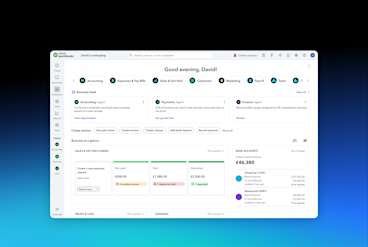
Cloud accounting
Automation vs AI vs Agentic: What every accountant should know
Simple, smart accounting software - no commitment, cancel anytime

GROWING YOUR BUSINESS
The hard part is over. The hours you spent sifting through resumes and conducting interviews are behind you (for now). You’ve just hired a new employee, and you know they’re going to be amazing. But it’s up to you to set up your new employee for success.
A positive onboarding experience can inspire confidence in your new employee. It can also increase their engagement and, ultimately, improve their longevity with the company. On the flip side, a poor onboarding experience can make a bad first impression your new employee won’t soon forget.
Developing a solid onboarding process can ensure a worthwhile onboarding experience for every new hire. And a comprehensive onboarding checklist can help ensure you never miss a step.
First impressions matter. When new hires experience poorly executed onboarding, they might assume the organisation is poorly managed. Once that happens, it can be difficult to change their perception. A third of respondents in a 2014 BambooHR survey said they’d quit a job within six months of starting. In those cases, they may have left their employers short-staffed and burdened with employee turnover.
But employees are 69% more likely to stay with a company for at least three years if they had a structured onboarding experience. And organisations say effective onboarding improves employee retention rates and productivity. Overall, a structured onboarding experience can make employees feel more confident in their employers and more engaged with their new roles. In short, onboarding is your opportunity to win over your new employees.
An onboarding process has lots of moving parts. Without a comprehensive checklist, it can be easy to miss a step. Fortunately, an onboarding checklist can help you ensure a positive and structured onboarding experience for every new hire.
We’ve done the heavy lifting for you. Download the checklist to get started. Then use the checklist as is or customise it for your onboarding process.
The onboarding process begins long before your new employee steps foot in the building. And it doesn’t end after 90 days. A solid onboarding process supports your new employee from the moment they accept your job offer through their first year of employment. We have a few tips to help you keep your employees on track for their first year and beyond.
To kick things off, here are a few things you can do before their first day:
Set up their employee accounts.
Provide their uniform, or share your company dress code.
Collect their emergency contact information.
Collect their banking information to set up direct deposit.
Ensure all parts of payroll are set up.
Send a welcome email with details about their first day, including where to park and what to bring.
Prepare their work station with necessary office equipment, an employee handbook, a first-day agenda, and a welcome gift.
Remember, first impressions matter. An employee’s first day is your first chance to build rapport. It’s a good idea to create opportunities for the employee to engage with their team and their new role.
Here are some things you can do on their first day:
Greet them when they arrive and escort them to their desk.
Introduce them to their new team. Consider scheduling a team lunch or activity to facilitate meaningful connections.
Conduct a tour of your facility or workplace. Don’t forget to point out the restrooms and common areas.
Schedule some time for them to meet with HR to complete any remaining paperwork.
Host a new employee orientation to discuss your company’s mission, vision, and goals. Share essential information about your products, services, and customers.
Schedule dedicated time for them to review the employee handbook. Discuss company policies and procedures.
Conduct an end-of-day check-in. Answer any questions, make sure they have everything they need, and let them know what to expect next time. This is an ideal time to ask for their feedback about their first day.
First impressions matter! A positive onboarding experience can inspire confidence and engagement in your new employee.
New hires get a lot of information on the first day. For the remainder of the week, it’s a good idea to reiterate and build on some of the most important points.
Beyond that, the first week is all about keeping your new hire engaged. By the end of the week, they should feel invested in the culture, the organisation, and their new job. People like to feel productive, so give your new employee tasks that can keep them engaged.
Here are some things you can do during their first week:
Begin role-specific training, and consider giving them small role-related tasks to help them ease in.
Set them up with a mentor or someone they can shadow or turn to with questions.
Schedule team lunches or activities with different groups each day. This encourages more one-on-one conversations and tighter connections.
Continue discussing company policies and procedures, culture, and goals.
Connect with them at the end of each day. Answer any questions they might have, gather feedback, and share expectations.
Your new employee may catch on quickly. But don’t halt your onboarding efforts when your employee starts feeling comfortable. The first month is an opportunity to ensure your employee is happy, confident, and engaged for the long run.
Here are some things you can do during their first month:
Schedule a check-in with HR. Your employee may have questions about PTO, health care, or other benefits, now that they’ve had some time to acclimate.
Continue with role-specific training and job shadowing. Branch out and schedule job shadowing with employees on different teams and roles to give your employee a full picture of company operations.
Schedule one-on-one time with your employee to discuss expectations, responsibilities, and more. Then set up a monthly, quarterly, and annual review process.
Gather their feedback. Ask them what they thought was great about their onboarding experience and what could have been better. This is your opportunity to improve.
As your employee gets more comfortable in their role and nears the end of their first 90 days, don’t lose steam! You don’t want them to feel abandoned after a few months on the job.
Here are some things you can do during their first 90 days:
Schedule one-on-one conversations to discuss their progress, goals, challenges, and feedback. These conversations can be with you, the HR team, or another manager.
Gather even more feedback. Find out what you could have done better and answer any remaining questions.
Schedule a team activity and do something fun! Team connections are critical for productivity and collaboration. The more you create opportunities to connect and engage as a team, the better.
No matter how long an employee has been with your company, it’s a good idea to review your company policies and expectations consistently.
Here are some things you can do to keep your employees on track through their first year of employment:
Complete monthly, quarterly, and yearly check-ins or reviews with all employees. Employees should always understand their roles, responsibilities, and expectations.
Review company policies and procedures with your entire team on an ongoing basis. Keep your employee handbook up to date, or show them how to use the employee portal to find the information they want.
Schedule monthly or quarterly team activities to keep company culture and team camaraderie strong.
Annual performance reviews are a common experience at many companies. But if you’re only meeting with your employees once or twice a year, you’re missing opportunities to connect. A consistent quarterly review process can keep employees on track and engaged.
Employees should always know how they’re performing, if they’re meeting expectations, and what they’re responsible for. There shouldn’t be any surprises in their year-end performance review. A quarterly review presents an opportunity to discuss an employee’s goals and how you can work together to achieve them.
Additionally, a quarterly review is a great time for you to gather feedback. A successful quarterly review is a two-way conversation. They help both parties understand what’s working well and what could use some improvement. When done right, a quarterly review process can benefit you and your employees.
The review process itself is unique to your team and your company. Do what works best for you—just make sure you do it.
Here are a few tips to help you make your quarterly reviews successful:
Make it official. Don’t meet for the sake of meeting. Set an agenda, come prepared, and document the conversation.
Make it a two-way street. In addition to giving feedback to your employee, ask for feedback. What’s going well? What could be better? What can you improve as a leader?
Take action. Every review should end with clear actions and next steps. And don’t forget to follow up.
Remember, new hires get a lot of information within their first days and weeks on the job. So circle back on a few key topics with all employees regularly. Review how to request paid time off (PTO), how to collect paychecks, your benefits package, and anything else they may have forgotten.
Paid time off can help workers maintain a work-life balance. A generous PTO policy can be a big draw for new employees. It shows them that you care about their personal and emotional well-being. Managers who encourage taking PTO can see increased employee engagement and productivity.
All employees need to understand your company’s PTO policies. These policies include how much PTO they can earn, when they can use PTO, and how to request time off. You should outline your time-off policies in your employee handbook or on your employee portal. Consider reviewing these policies with all of your employees regularly.
No matter how fulfilling the job might be, employees work to get paid. All employees should understand their payment schedule, how to collect their paychecks, and how their checks will look.
Beyond that, employees should be aware of any additional financial opportunities your company offers. These opportunities include things like retirement benefits, employee stock purchase plans, reimbursement benefits, and more. As always, you should outline these benefits in your employee handbook and review them with all employees regularly.
Health care is a valuable benefit for employees, but it can be confusing. Many companies offer multiple levels or different types of health care plans. Employees need to understand the health care benefits available to them and how to take full advantage of their plan. Regularly reviewing these benefits with your employees can help you spot opportunities for improvement as your company grows.
Your company culture is the lifeblood of your business. It’s what keeps your employees engaged in their jobs and loyal to your company. A strong company culture improves employee productivity and longevity and makes it easier to recruit strong applicants.
As your company grows, you risk outgrowing your company culture. But having regular discussions about company culture allows you to keep your culture at the forefront. When you help employees align with the company’s vision and mission, they better understand their expectations and contributions.
Discover QuickBooks Online today
Feel you’re better informed about how to onboard new employees? The QuickBooks blog covers a wide range of business-related topics – it’s all part of our mission to help small businesses grow.
Subscribe to get our latest insights, promotions, and product releases straight to your inbox.
9.00am - 5.30pm Monday - Thursday
9.00am - 4.30pm Friday